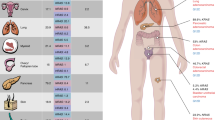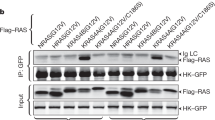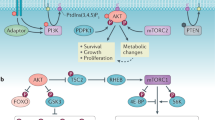Abstract
Neoplastic cells transport large amounts of glucose in order to produce anabolic precursors and energy within the inhospitable environment of a tumor. The ras signaling pathway is activated in several cancers and has been found to stimulate glycolytic flux to lactate. Glycolysis is regulated by ras via the activity of 6-phosphofructo-2-kinase/fructose-2,6-bisphosphatases (PFK2/FBPase), which modulate the intracellular concentration of the allosteric glycolytic activator, fructose-2,6-bisphosphate (F2,6BP). We report herein that sequential immortalization and ras-transformation of mouse fibroblasts or human bronchial epithelial cells paradoxically decreases the intracellular concentration of F2,6BP. This marked reduction in the intracellular concentration of F2,6BP sensitizes transformed cells to the antimetabolic effects of PFK2/FBPase inhibition. Moreover, despite co-expression of all four mRNA species (PFKFB1-4), heterozygotic genomic deletion of the inducible PFKFB3 gene in ras-transformed mouse lung fibroblasts suppresses F2,6BP production, glycolytic flux to lactate, and growth as soft agar colonies or tumors in athymic mice. These data indicate that the PFKFB3 protein product may serve as an essential downstream metabolic mediator of oncogenic ras, and we propose that pharmacologic inhibition of this enzyme should selectively suppress the high rate of glycolysis and growth by cancer cells.
This is a preview of subscription content, access via your institution
Access options
Subscribe to this journal
Receive 50 print issues and online access
$259.00 per year
only $5.18 per issue
Buy this article
- Purchase on Springer Link
- Instant access to full article PDF
Prices may be subject to local taxes which are calculated during checkout






Similar content being viewed by others
References
Atsumi T, Chesney J, Metz C, Leng L, Donnelly S, Makita Z et al. (2002). Cancer Res 62: 5881–5887.
Blum R, Jacob-Hirsch J, Amariglio N, Rechavi G, Kloog Y . (2005). Cancer Res 65: 999–1006.
Boren J, Cascante M, Marin S, Comin-Anduix B, Centelles JJ, Lim S et al. (2001). J Biol Chem 276: 37747–37753.
Boros LG, Bassilian S, Lim S, Lee WN . (2001). Pancreas 22: 1–7.
Boros LG, Torday JS, Lim S, Bassilian S, Cascante M, Lee WN . (2000). Cancer Res 60: 1183–1185.
Chesney J, Bucala R . (2001). Biotechnol Int 3: 213–220.
Chesney J, Mitchell R, Benigni F, Bacher M, Spiegel L, Al-Abed Y et al. (1999). Proc Natl Acad Sci USA 96: 3047–3052.
Chesney J, Telang S, Yalcin A, Clem A, Wallis N, Bucala R . (2005). Biochem Biophys Res Commun 331: 139–146.
Hamilton JA, Callaghan MJ, Sutherland RL, Watts CK . (1997). Mol Endocrinol 11: 490–502.
Hue L, Rousseau GG . (1993). Adv Enzyme Regul 33: 97–110.
Kessler R, Eschrich K . (2001). Brain Res Mol Brain Res 87: 190–195.
Kole HK, Resnick RJ, Van Doren M, Racker E . (1991). Arch Biochem Biophys 286: 586–590.
Mahlknecht U, Chesney J, Hoelzer D, Bucala R . (2003). Int J Oncol 23: 883–891.
Manzano A, Rosa JL, Ventura F, Perez JX, Nadal M, Estivill X et al. (1998). Cytogenet Cell Genet 83: 214–217.
Mazurek S, Zwerschke W, Jansen-Durr P, Eigenbrodt E . (2001). Oncogene 20: 6891–6898.
Minchenko A, Leshchinsky I, Opentanova I, Sang N, Srinivas V, Armstead V et al. (2002). J Biol Chem 277: 6183–6187.
Minchenko O, Opentanova I, Caro J . (2003). FEBS Lett 554: 264–270.
Minchenko O, Opentanova I, Minchenko D, Ogura T, Esumi H . (2004). FEBS Lett 576: 14–20.
Mueller-Klieser W, Freyer JP, Sutherland RM . (1986). Br J Cancer 53: 345–353.
Navarro-Sabate A, Manzano A, Riera L, Rosa JL, Ventura F, Bartrons R . (2001). Gene 264: 131–138.
Okar DA, Lange AJ . (1999). Biofactors 10: 1–14.
Racker E, Resnick RJ, Feldman R . (1985). Proc Natl Acad Sci USA 82: 3535–3538.
Ramanathan A, Wang C, Schreiber SL . (2005). Proc Natl Acad Sci USA 102: 5992–5997.
Sakai A, Kato M, Fukasawa M, Ishiguro M, Furuya E, Sakakibara R . (1996). J Biochem (Tokyo) 119: 506–511.
Sakakibara R, Kato M, Okamura N, Nakagawa T, Komada Y, Tominaga N et al. (1997). J Biochem (Tokyo) 122: 122–128.
Sakakibara R, Okudaira T, Fujiwara K, Kato M, Hirata T, Yamanaka S et al. (1999). Biochem Biophys Res Commun 257: 177–181.
Soejima K, Fang W, Rollins BJ . (2003). Oncogene 22: 4723–4733.
Taetle R, Rosen F, Abramson I, Venditti J, Howell S . (1987). Cancer Treat Rep 71: 297–304.
Valenzuela DM, Groffen J . (1986). Nucleic Acids Res 14: 843–852.
Van Den Berghe N, Ouwens DM, Maassen JA, Van Mackelenbergh MG, Sips HC, Krans HM . (1994). Mol Cell Biol 14: 2372–2377.
Van Schaftingen E, Jett MF, Hue L, Hers HG . (1981). Proc Natl Acad Sci USA 78: 3483–3486.
Van Schaftingen E, Lederer B, Bartrons R, Hers HG . (1982). Eur J Biochem 129: 191–195.
Vizan P, Boros LG, Figueras A, Capella G, Mangues R, Bassilian S et al. (2005). Cancer Res 65: 5512–5515.
Walenta S, Schroeder T, Mueller-Klieser W . (2004). Curr Med Chem 11: 2195–2204.
Wang T, Marquardt C, Foker J . (1976). Nature 261: 702–705.
Warburg O, Negelein E . (1924). Biochemische Zeitschrift 152: 319–344.
Wechalekar K, Sharma B, Cook G . (2005). Clin Radiol 60: 1143–1155.
Zhong H, De Marzo AM, Laughner E, Lim M, Hilton DA, Zagzag D et al. (1999). Cancer Res 59: 5830–5835.
Acknowledgements
We thank Robert Mitchell for providing the rasV12 and LT retroviruses and Barrett Rollins for providing the hT, hT/Lt and hT/LT/ras bronchial epithelial cells. We gratefully acknowledge helpful discussions with Douglas Dean and Otto Grubraw. This work was supported by the following grants: NIH 1P20 RR18733 (JC), NIH 1 R01 CA11642801 (JC), and the P Morris External Research Program (JC and JWE).
Author information
Authors and Affiliations
Corresponding author
Rights and permissions
About this article
Cite this article
Telang, S., Yalcin, A., Clem, A. et al. Ras transformation requires metabolic control by 6-phosphofructo-2-kinase. Oncogene 25, 7225–7234 (2006). https://doi.org/10.1038/sj.onc.1209709
Received:
Revised:
Accepted:
Published:
Issue Date:
DOI: https://doi.org/10.1038/sj.onc.1209709
Keywords
This article is cited by
-
Targeting Aurora-A inhibits tumor progression and sensitizes thyroid carcinoma to Sorafenib by decreasing PFKFB3-mediated glycolysis
Cell Death & Disease (2023)
-
Overexpression of PFKFB3 promotes cell glycolysis and proliferation in renal cell carcinoma
BMC Cancer (2022)
-
EVs delivery of miR-1915-3p improves the chemotherapeutic efficacy of oxaliplatin in colorectal cancer
Cancer Chemotherapy and Pharmacology (2021)
-
PFKFB2 regulates glycolysis and proliferation in pancreatic cancer cells
Molecular and Cellular Biochemistry (2020)
-
Small Molecule KRAS Agonist for Mutant KRAS Cancer Therapy
Molecular Cancer (2019)



